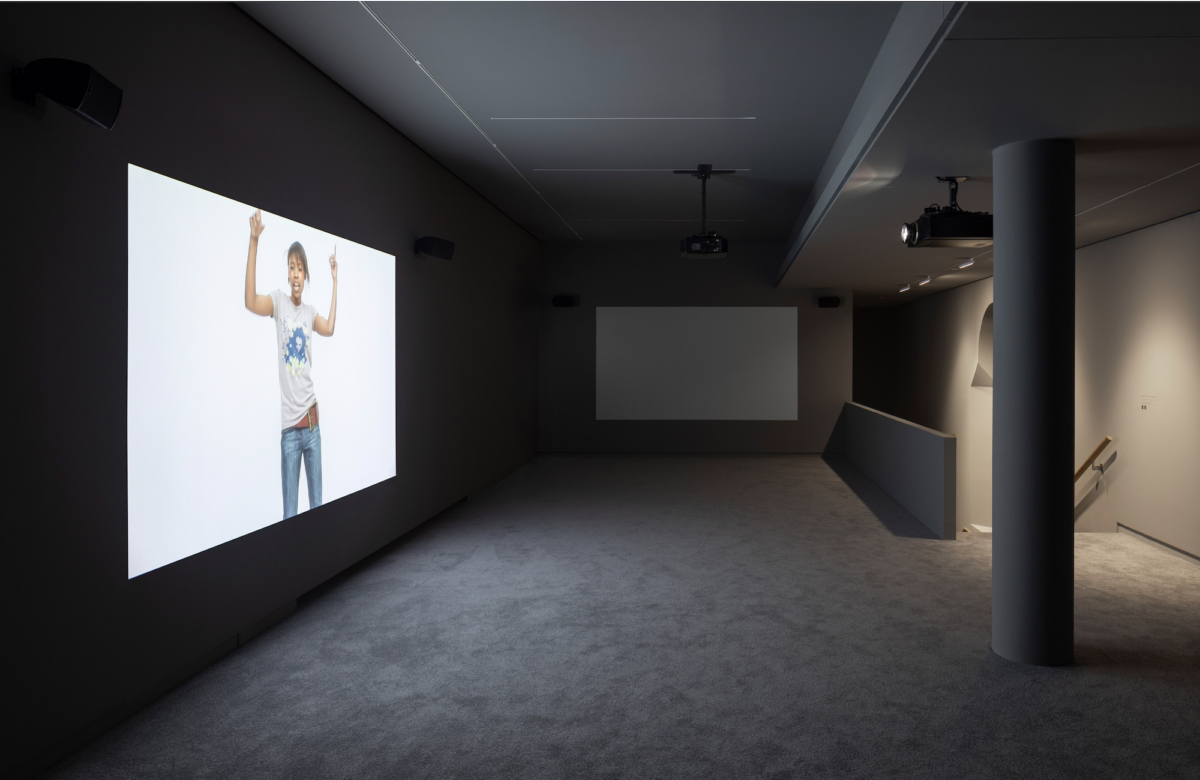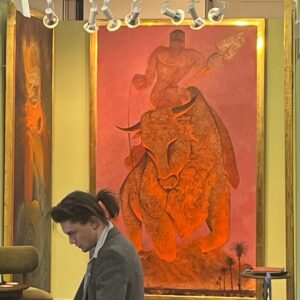Beth, Amy, Shelby, Nicky: four ink-jet portraits, three-quarter in view and about life-size in scale, stand in a soft atmosphere of French grey — their pictorial backgrounds as well as the exhibition space housing them. Cool and confident with a hint of performativity, the protagonists in these photos face out, with each of their mascara-laden lashes pressed towards the means of their filmic production: Rineke Dijkstra and her camera.

Next, follow the pops of sound.
Megan, Simon, Nicky, Philip, Dee: five to-camera-video sequences, each the length of a song and projected at a more than human scale, show adolescents dancing on their own. Filmed before a backdrop of white, these youthful protagonists sway and stutter, overcome in their bodily response to a pop, rock or nightclub remix of their choosing. We hear this loud. With slow-quick shoulder steps, and smiles that waver, these ecstatic bodies gleam through the music, personifying the corporeal release, the freedom, found in subcultural intoxication.

Life is all liquid in this krazy house.
For context:
The first figure I see in Espace Louis Vuitton München’s presentation of Rineke Dijkstra’s artwork The Krazy House (Megan, Simon, Nicky, Philip, Dee), 2009 — the figure used in the promotional materials for the exhibition as well as the first photographic portrait I see upon entering the exhibition space — looks a bit like the minor character Chloe in Sofia Coppola’s 2013 film The Bling Ring. A film about troubled teen becomings, set in the star-splashed Hollywood Hills, its narrative unfolds with Anna Delvey-esque vibes; we do not follow the film’s teen syndicate as they walk the Hall of Fame dreaming, but pursue their ploy to live all silver-screen glitz and glam. It ends badly.

This reference isn’t the best… nor one to cling too tightly to when thinking about Dijkstra’s four-channel film installation and the photo prints shown alongside at Espace. Another, more apophenia-toned and equally irrelevant reference: each member of Dijkstra’s cast has a statuesque presence, a quality that reminds me of ancient Greek kore or kouros statues. Like those stoic embodiments of (capital Y) Youth, female and male respectively, the figures that compose The Krazy House — filmic and photographic iterations — stand dignified in their looking, the grace in their posses accentuated by Dijkstra’s sensitive handling of the camera medium; the crop and focus of her scenes affords each member of her cast a life beyond the lens, suggesting that each portrait is an idiom not an icon — a more general mode of expression rather than a fixed marker for existence.


Dijkstra found the five protagonists of The Krazy House (Megan, Simon, Nicky, Philip, Dee) whilst spending time in Liverpool and engaging with the city’s club scene; often thought of as spaces of personal freedom and expressive openness, where people can discover themselves. Perhaps the best example of this musical intoxication and the corporal freedom it affords can be seen in the video sequence focusing on Dee. With David Guetta and Kelly Rowland tinges in the fimlic air, Dee, simply dressed in jeans and a t-shirt with a fantastically oversized belt — a la aughts fashion — eyes Dijkstra’s camera tentatively; with a bitten lip and fists held close to their chest as they wriggle, overtly self-conscious and shy in front of this mechanical gaze. As the pulse of Guetta ft. Rowland picks up — “When love takes over yeaaah” — the pop-beat drop leaks into Dee’s body. Beaming now their arms rise and fall as they get all carried away in the rhythmical act of finding themselves in the music. One amongst an assemble of five, sharing the space of four projection screens, Dee and the rest of Dijkstra’s cast — Megan, Simon, Nicky and Philip — represent something of the diverse nature of human identity, a fact naively conveyed in the installation via each youth’s differing style of dress and dance moves. Further, unbound from any bare narrative or choreographic score the installation’s protagonists move diffrently together, with an affinity, becoming bodily expressions of self-hood, seen as something plural and porous; a quality of self realised when the lights are turned off on sociocultural expectations and one just flows with the personal resonances of lifes music.

Rineke Dijkstra “The Krazy House” May 3rd to September 14th, 2024, Espace Louis Vuitton Munich
‘Seen as part of Various Others‘






